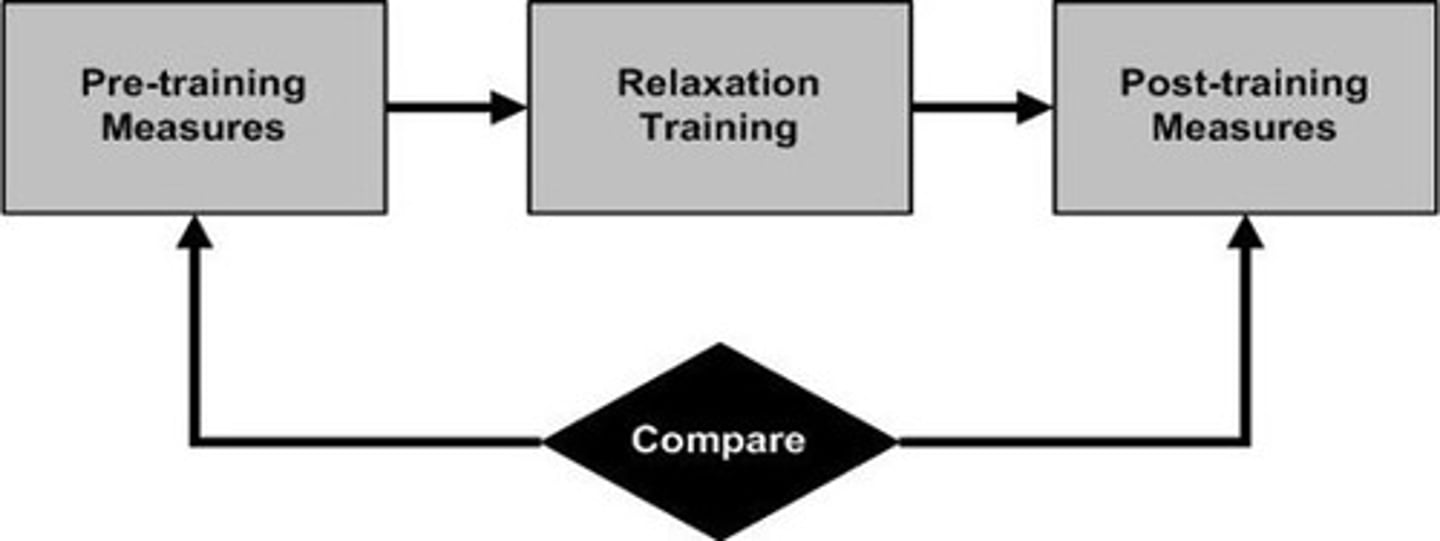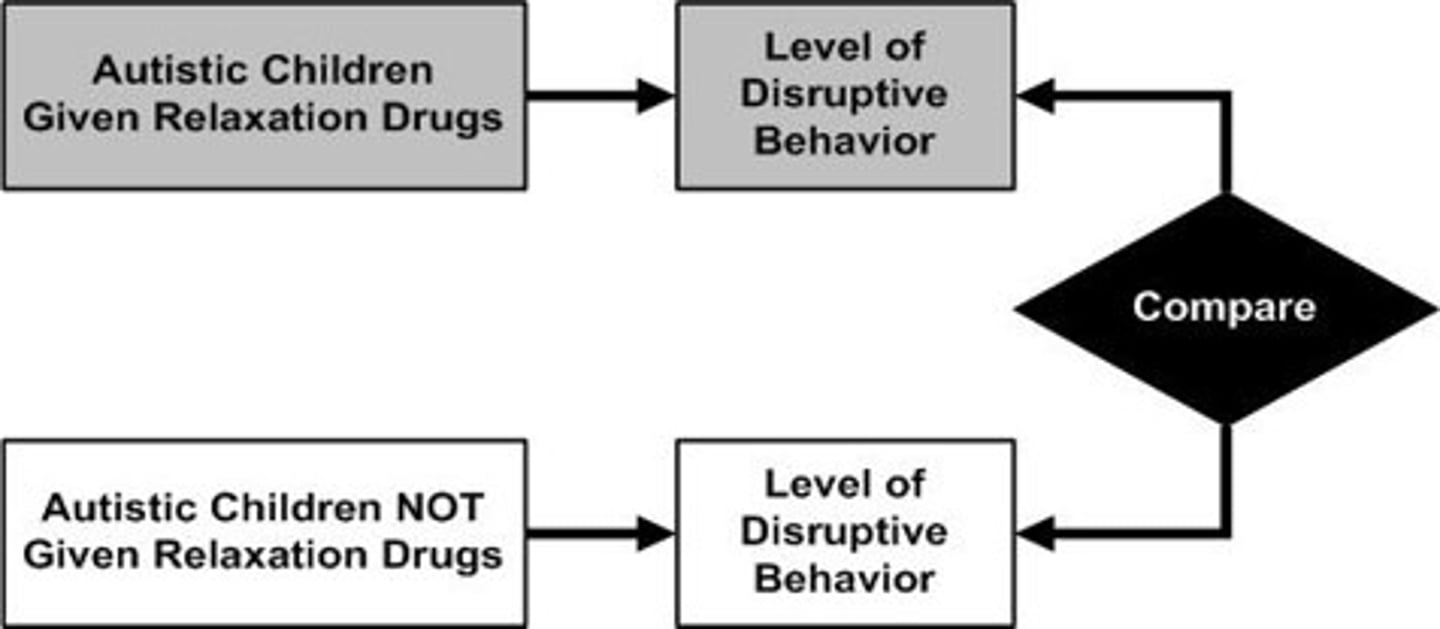Experimental Psychology Exam 3
1/54
There's no tags or description
Looks like no tags are added yet.
Name | Mastery | Learn | Test | Matching | Spaced |
|---|
No study sessions yet.
55 Terms
What are parts of a good research hypothesis?
Ideas lead to
• observations
• library research
Statement of problem
Problem statements become research hypotheses when constructs are operationalized
Research Hypotheses
Declarative sentence: Brief and clear
Identifies at least 2 variables
States a predicted relationship with direction
Testing Research Hypotheses
Actually testing three sets of hypotheses
• The null hypothesis
• The confounding variable hypotheses
• The causal hypothesis
Accept causal hypothesis only if you
Reject the null hypothesis (statistical analysis)
Rule out each potential confounding variable hypothesis
(based on appropriate controls)
Types of Validity
Statistical Validity
Construct Validity
External Validity
Internal Validity
Statistical Validity
Are the statistical tests accurate?
Threatened by
• Unreliable measures
• Violations of statistical assumptions
Strengthened by
• Using well-validated measures
• Not violating assumptions of the statistic (e.g., linearity, normal distribution, equal group sizes, etc.)
Construct Validity
Threatened by
• Any alternative explanation for the results
Strengthened by
• Using well-validated constructs to build the theoretical predictions for the study
Internal Validity
Is the independent variable responsible for the observed changes in the dependent variable?
Threatened by
• Confounding variables
Strengthened by
• Adding adequate controls to reduce or eliminate
confounding
External Validity
Do the results apply to the broader population?
Threatened by
• Unrepresentative samples
• Generalizing beyond the limits of the sample
Strengthened by
• Gathering a representative sample (if possible)
• Clearly describing the sample, so that other researchers will know the limits of generalization
internal validity vs external validity
INTERNAL VALIDITY - The degree to which a researcher controls for and reduces the effects of extraneous variables that can affect study outcomes so that they represent true outcomes.
EXTERNAL VALIDITY - The degree to which results from an experiment can be generalized to other individuals beyond the study.
What are the 9 threats to internal validity?
1. History
2. Maturation
3. Testing
4. Instrumentation
5. Regression of the mean
6. Selection
7. Attrition
8. Diffusion of treatment
9. Sequence Effects
History
Changes due to an event that occurs during the study
Maturation
Changes due to growth or predictable changes
Testing
Changes due to the effects of previous testing
Instrumentation
Any change in the calibration of the measuring instrument over the course of the study
Regression of the mean
Tendency for participants selected because of extreme scores to be less extreme on a retest
Selection
Any factor that creates groups that are not equal at the start of the study
Attrition
Loss of participants during a study; are the participants who drop out different from those who continue?
Diffusion of treatment
Changes in participants' behavior due to information they obtained about other conditions
Sequence Effects
Effects on performance in one condition due to experience with previous conditions
Subject Effects
Participants are not passive
• _______: Changes in behavior due to being in a study and not the IV
• Demand characteristics
Placebo effect
Demand characteristics:
Cues given to participants on how the researcher expects them to behave
Placebo effect
Treatment effect due to expectations that the treatment will work
Experimenter Effect
Any biasing effects in a study that are due to the actions of the researcher
Based on the expectations of the researcher
It can affect the outcome of studies if not controlled
Maybe due to the experimenter providing demand characteristics to the participant
Not the same as scientific fraud (which is deliberate)
Pretest-Posttest Design
Single-group, pretest-posttest design compares pre-treatment and post-treatment scores to determine whether improvement occurs.
The simple pretest-posttest design fails to control many sources of confounding
• History, Maturation, Regression to the Mean, etc.
However, it fails to control most sources of confounding.

Two-group, Posttest-only Design
Compares different treatments on an outcome measure
Much stronger than a single-group, pretest-posttest design

Control Procedures
General control procedures (applicable to virtually all research)
Control over subject and experimenter effects
Control through the selection and assignment of participants
Control through experimental design
General Control Procedures
Preparation of the setting
Response Measurement
Replication
Preparation of the setting
Free of distractions that might interfere
A natural setting increases external validity
Response Measurement
Use reliable and valid measures
Replication
Demonstrates that findings are consistent and robust
Subject and Experimenter Effects
Blind procedures
Automation
Using objective measures
Multiple observers
Using deception
Balanced Placebo Design
Blind procedures
Best control for expectancy effects
Single-blind
Double-blind
Single-blind
The experimenter does not know what condition the participant is in
Double-blind
Neither the experimenter nor the participant knows what condition the participant is in
Automation
Reduces contact between participants and the experimenter
Gives the experimenter less opportunity to affect participants
Using objective measures
Objective measures require less judgment
Provides less opportunity for subtle experimenter biases to affect the data
Multiple observers
Reduces bias because it challenges observers to be as precise and objective as possible
Can measure the amount of observer agreement (percent agreement or Kappa)
Using deception
Hides the purpose of the study from participants
Balanced placebo design is a good example
Balanced Placebo Design
Separates the pharmacological effects from the expectancy effects of alcohol
A two-factor design
• Factor 1 is whether the person drinks alcohol
• Factor 2 is whether the person thinks he or she is drinking alcohol
Participant Selection
Can generalize only if your sample is representative
Populations and samples
• General population
• Target population
• Accessible population
• Sample
General population
all potential participants
Target population
those participants you are interested in
Accessible population
portion of target population that is available to the researcher
Sample
drawn from the accessible population
Random sampling
Every participant has an equal chance of being sampled
Stratified random sampling
Random sampling within strata (subgroups)
Ad hoc samples
Random sample from accessible population
Must generalize cautiously
Should describe a sample to help define the limits of generalization
Convenience sampling
choosing individuals who are easiest to reach
Free random assignment
Random assignment of participants to groups
Randomize within blocks
Randomly assign in blocks of one participant per condition
Matched random assignment
Random assignment of participants in matched sets to groups
Matched Random Assignment
Match on relevant variables
• Variables likely to affect the dependent measure
• Variables that show the largest variability in the population Procedures
• Match in sets on the relevant variable
• Set size is the number of groups in the study
• Randomly assign participants from the set, one to each group• Keep track of matching data for the statistical analysis
Experimental Design
Experimental design maximizes validity
• Need to also include the other control procedures covered in this chapter
Key elements of experiments
• One or more control groups
• Random assignment of participants to groups
Randomized Pretest-posttest Control-group Design
The control-group design controls most sources of confounding, PROVIDED the groups are equivalent
• Use random assignment to assure equivalence